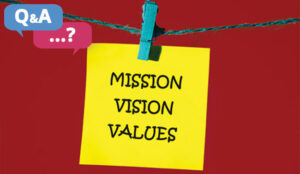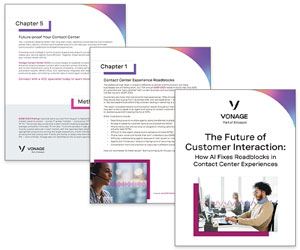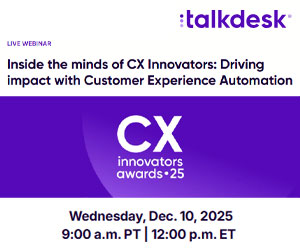Our panel of experts share how to create truly impactful customer service mantras and vision statements.
In this article we will explore:
- What’s the Difference Between a Mantra and a Vision Statement?
- How to Create a Customer Service Mantra
- How to Create a Customer Service Vision Statement
- The Power of Purpose
What’s the Difference Between a Mantra and a Vision Statement?
A Customer Service Mantra
A customer service mantra is a single sentence that acts as a focal point for all employees, summarizing what your service experience is all about.
It should be widely communicated and easily recited by everyone who works there. It’s likely already (or will be) part of your customer service vision statement – you just need to extract it.
A Customer Service Vision Statement
A customer service vision statement is notably longer and contains more detailed strategic information about what, why and how you’re going to deliver the service your customers expect.
It extends to targets around service levels, metrics, and more. An extract or abbreviated version of this will inform your customer service mantra.
How to Create a Customer Service Mantra
Creating a customer service mantra can be a daunting task, but it doesn’t need to be. You just need to think it through and approach its creation in a logical manner.
With this in mind, we have put together some top advice on how to create a customer service mantra:
1. Know What a Mantra Looks Like
The first step in creating a customer service mantra is starting with the basics, and not only identifying what a mantra is, but also how you want it to sound:
Keep It Short and Easy to Remember

Your customer service mantra needs to be short (just one sentence!), to the point, and easily remembered.
It should act as a North Star, allowing agents to check themselves against that statement and take positive action towards achieving it.
For example, if your mantra is “be helpful”, you can train agents on how to be helpful, and your agents can easily ask themselves “am I being helpful today?”.
Make It A bit Cheesy (If You Want It to Be)
It doesn’t necessarily have to be a professional marketing statement to the outside world either. It can be a bit cheesier, relaxed, or even a passion statement.
For example, I knew one company whose internal mantra was something like “We love our clients so much that when we kiss them, they bleed.”
It wasn’t part of the official brand guidelines, but it helped agents to live and breathe how seriously the company took customer service.
Contributed by: Shep Hyken, CAO (Chief Amazement Officer) at Shepard Presentations LLC
2. Identify Who to Involve in the Process
Next, you need to think about and identify who needs to be involved in creating your mantra, as without the right people, you will struggle to make it meaningful and relevant.
Everyone Has a Role to Play in Delivering a Great Customer Experience

The most important part of creating your mantra is realizing that every employee has a role to play.
Manufacturing, sales, marketing, billing, distribution, and human resources, as well as the contact centre, play a role in delivering a great customer experience.
So, involve all those departments in the process of creating your customer service mantra. You can gain their input via surveys and focus groups, if you like, to help you to craft the mantra.
Contributed by: Mike Aoki, President of Reflective Keynotes Inc.
Beware Getting the Wrong People Together
The creation of your customer service mantra can be seriously compromised if you don’t have enough people (or the right people) together in the first place.
Ideally, you’re looking for 5 or 6 people representing different areas of the business, bringing a broad range of perspectives together.
You may also want to put a vote out to all employees at some stage, but the core team should still be small and focused.
Contributed by: Shep Hyken, Shepard Presentations LLC
3. Know the Mistakes to Avoid
Once you’ve thought about what you want your mantra to sound like and identified who to involve, you are ready to get started, but as you do, it is worth keeping in mind these mistakes to avoid:
Overlooking the Need for Communication
Your mantra will never capture the hearts and minds of your employees if you don’t invest time in communicating it to everyone.
The mantra should be heard often and felt as a living, breathing part of the company culture.
So much so that you should be able to walk up to any employee across the company and ask, “what is our mantra?” and they should be able to recite it without hesitation.
Delaying Introducing the Mantra
Your mantra should be present from Day 1 in employees’ careers with you. They should hear it for the first time at the interview, again during their onboarding, and awareness should be sustained with ongoing mentions and reminders.
Contributed by: Shep Hyken, Shepard Presentations LLC
Forgetting to Test Your Mantra
It is important to go back and test market your finalized mission statement with each department. Does it inspire each internal team to provide better customer support? Or is the proposed mantra too vague and lofty to truly inspire action?
You can also test market it with focus groups of customers. Is it meaningful to your customers? Does it make them want to do business with your company?
Contributed by: Mike Aoki, Reflective Keynotes Inc.
How to Create a Customer Service Vision Statement
You are looking to create a customer service vision statement, but where do you start?
We’ve asked the experts for their top suggestions on how to create a customer service vision statement that your whole company can get behind.
1. Identify Why You Need One
Knowing why you are creating a customer service vision statement can make it much easier to put one together. So you need to know why are you creating a vision statement, right?
An Agreement on Common Goals for the Future

It is very easy for customer service to drift along at its own pace, driven by several factors.
Customer service evolves over time and is often influenced by technology shortfalls, process failure, and a lack of clarity of the role for customer services within an organization.
A vision enables stakeholders to reach an agreement and have common goals for the future and what customer service aspires to be.
Contributed by: Martin Jukes, Managing Director at Mpathy Plus
2. Identify Who to Involve in the Process
After you have identified why you need a customer service vision statement, you need to think about who needs to be involved in its creation.
Marketing, Sales, and CX Leaders Will All Have a Perspective

Developing a new customer service vision and new standards for service delivery cannot occur in a vacuum.
The vision must be designed keeping in mind the expectations created, brand and customer profiles, and personas.
To build out this vision, you will need the assistance of many people and groups within the organization. Nobody has exclusive dominion over the customer. Marketing, Sales, and CX leaders throughout the organization will all have a perspective related to what the vision should be.
You will need to facilitate discussions and work groups to assess your current messaging, brand promise, accessibility, service delivery, and ease.
Contributed by: Colin Taylor, CEO of The Taylor Reach Group, Inc
Include as Many as Possible in Developing the Vision
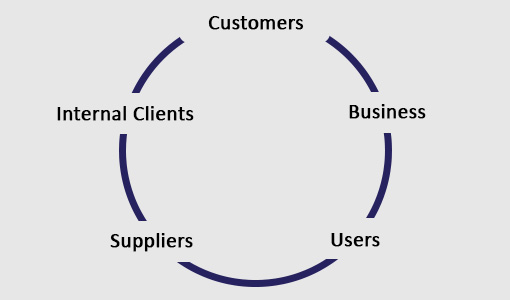
There are numerous stakeholders involved in customer service (as shown opposite). It is highly desirable to include as many as possible in developing the vision.
The majority of stakeholders are within the organization, and should all work together to develop the vision. They should be key in providing insight into what customers want and expect.
This can be developed through market intelligence and looking at competitors.
The remining stakeholders should work together to develop and agree the vision. This is best done through workshops that involve sponsorship from an executive level.
Workshops should be facilitated by somebody external to the process, but there should also be an executive sponsor to steer the group and provide the business input – for example, alignment with the corporate plan.
Don’t Forget the Support Services – Including HR
Support services such as HR, IT and Finance all have an essential role to play in supporting customer service.
Whilst they may have less to add to the vision, their involvement provides a better understanding of what they need to deliver to customers and the challenges faced by all.
Contributed by: Martin Jukes, Mpathy Plus
3. Consider and Decide What to Include
After you’ve identified why you need a vision statement and who you need to involve in creating one, you then need to define what needs to be included in it.
To help with this, here are a few suggestions on what you need to consider:
Define the Purpose of the Vision Statement

You should start by looking at the purpose for writing the vision statement.
It’s not all about the statement, it’s more about what lies underneath the statement, and how the statement is being supported throughout the company, so that the customer service promised to customers is actually delivered to the customers.
Ask Yourself These 3 Questions:
- What is the purpose of the vision statement?
- What is the business need that you’re trying to solve by having the statement and how do teams align to deliver this?
- How does it help the customer?
Contributed by: Sue Duris, Principal Consultant at M4 Communications, Inc.
Define Your Customers
Any customer service vision needs to define and articulate who the customers are. This will allow you to focus your efforts.
With the definition of your customers, you can then look at what expectations you have already set out in your marketing and communications materials. These messages could originate in your wider company values.
You then need to consider how these expectations translate into operational service parameters. For example, what does “world-class customer support” really mean?
Review the Customer Journey
You will need to revisit or create customer journey maps to define or validate the journeys, and evaluate each contact touchpoint regarding the service delivered.
You can then ask yourself questions such as “is an Average Speed of Answer (ASA) of 20 seconds consistent with the expectations we have created?”
Additional questions include:
- Are we accessible to the customers?
- How easy is it for them to interact with us?
- Are we employing the best/most appropriate channel(s) for this interaction?
- What is preventing us from making this interaction faster, easier for the customer, and simpler for the agent?
- Would automation of this interaction support or detract from our customer service vision?
Check if Your Metrics Are Fit for Purpose
Metrics including CSAT, NPS, Service Level, Average Speed of Answer, Abandon Rate, First Contact Resolution rate, Customer Effort, and customer churn will need to be reviewed and assessed to validate the current service being delivered.
Contributed by: Colin Taylor, The Taylor Reach Group, Inc
Think About What Your Service Should Look Like
Key areas to consider and include in developing a vision:
- Service Definition – What should service look like? Self-service? High quality one-to-one engagement? How does it align with the business objectives?
- Services – What services will customer service be delivering? Sales, product support, service requests, technical support?
- Channels – What channels will be used to deliver customer service? Phone, email, social media, online, face to face?
- Resources – What resources are required and how will they be deployed? Office-based, homeworking, hybrid?
- Technology – What systems and tools are required to support customer service and where does the information come from/go to? Customer contact systems, CRM, WFO, knowledge?
- Sourcing – Is customer service outsourced, delivered in house, or a combination of the two?
- Value – Where does customer service add value? Increased sales? Improved customer data?
As you can see, even at a high level the vision starts to develop some detail, but it should be remembered that we are talking about an outline of the future, rather than the detail of what is already there.
Contributed by: Martin Jukes, Mpathy Plus
If you are looking for more information on what to include, read our article: What Should You Put in a Customer Service Vision Statement?
4. Know Which Mistakes to Avoid
With the right direction, right people, and right considerations, you can start to put together your customer service vision statement. However, it is worth keeping an eye out for these common mistakes:
Missing the Opportunity
Think strategically. The objective is to develop a vision that meets all stakeholders’ needs. There is an opportunity to design a solution and a vision for the future.
This may not be possible to deliver straight away, but having a strategic vision will encourage the ongoing development of your customer service.
Steering Away From Corporate Objectives
Align with corporate objectives. It is very easy for customer service to develop a life of its own and in some cases even start to lead the direction of the organization.
Whilst customer services can provide great insight on organizational performance and even quality feedback, it needs to align with the overall objectives of the business.
If that is growth, then the vision should enable growth. If it is cost reduction, then it should focus on being efficient.
Only Thinking Internally
Don’t forget to look from the customer’s perspective too.
Don’t forget to look from the customer’s perspective too. It is very easy to focus on developing a vision that is easy to deliver from an internal perspective, but service is there for customers.
It is vital that any vision is viewed from a customer’s perspective to ensure that it actually meets (or exceeds) their expectations and needs. Note, this is often difficult for involved stakeholders in the process to achieve so an independent perspective is helpful.
Focusing Too Much on Technology
Don’t focus too much on technology. This is a very common mistake, where technology providers have influenced a vision rather than supported the delivery of it.
Technology is one area of customer service and it needs to be shaped around the vision. However, this is often complicated by those supplying technology having a greater understanding of the functionality available.
Contributed by: Martin Jukes, Mpathy Plus
Not Thinking of or Including the Wider Business
The biggest mistake that customer service can make is to create a vision statement without thinking about the purpose of it, how it impacts customers, and how it impacts the business.
I think of it as a promise to the customer, as well as to the business. It serves as a compass – where are we now, where do we want to go, and how do we live this every day?
The process is not unlike a customer journey mapping session where teams – not just the customer-facing ones – get in a room and discuss the type of customer service they want to provide.
Tasks should include:
- Getting an executive sponsor to champion this process.
- Gathering materials that are already on hand (e.g. corporate vision and brand promise).
- Asking customers what they think of the existing customer service and what it should be.
- Asking employees what they think the company’s customer service mission should be.
The customer service vision should align with the corporate vision, and everyone should buy into and take ownership of it.
Contributed by: Sue Duris, M4 Communications, Inc.
Examples of Vision Statements
Good Examples
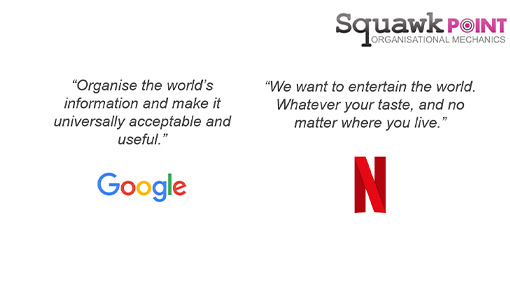
Bad Examples
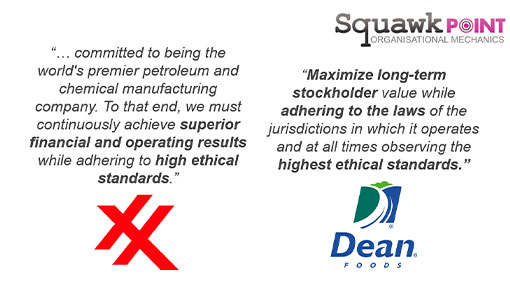
The Power of Purpose
Here, James Lawther, Director at Squawk Point Consulting, explains how creating a customer service vision statement creates a sense of purpose – and just how powerful that can be.
Thinking in Systems
A branch of academia called ‘systems thinking’ studies how the world works.
According to Wikipedia:
“Systems thinking is a way of making sense of the world’s complexity by looking at it in terms of wholes and relationships rather than splitting it down into parts.”
The systems thinkers categorize systems (or, in this case, organizations) into three elements:
- Components – The team members and functions, the factories, warehouses, and departments.
- Interactions – The information flows, rules, policies, and procedures that hold the components together.
- Purpose – The thing that the components and interactions are there to do.
It follows that there are also three ways to change the performance of your organization:
- Change the Components – Open and close factories, or hire and fire people.
- Change the Interactions – Provide new information, and change the rules.
- Change its Purpose – Focus it on something new.
Changing the Components
Managers typically put their attention on changing components. It is easy to imagine how a new telephony system or an outsourced service provider could change performance.
People are also components in a system, and managers try to improve them using a “best people” strategy that rigorously removes poor performers, or by reorganizing them into different departments and line managers. All this activity focuses on changing and moving the system’s individual parts.

Yet an improvement programme that focuses on improving the individual elements of an organization is likely to fail.
One of the gurus of systems thinking, Dr Russell L. Ackoff, explained why with one of his thought experiments. (You can – and should – listen to him speak on YouTube.)
Ackoff’s experiment suggests that you take every new car available on the market and park them in an oversized garage.
Then find a team of the brightest automotive engineers and ask them to evaluate each vehicle to determine the best parts.
They might say that the best transmission comes from a Range Rover, the best engine can be found in a Lamborghini, the best upholstery is in a Rolls Royce, and the best safety impact systems are to be found in a Volvo.
Once you have determined the best parts, imagine putting them together to create a “best of the best” motor car (managers call this a “best-of-breed” strategy).
Unfortunately, this won’t give you the best vehicle possible. Instead, you end up with a pile of parts that won’t move anywhere. The reason why not is simple: the pieces don’t fit.
It sounds obvious, and any systems integrator will agree. If you buy a “world-class” customer management system or move to a new “world-class” outsourced supplier, 80% of the project effort comes from integrating it into the business you already have. Individual parts by themselves are useless. They are only valuable once they have been stitched together.
Managing the Interactions
The second level of the systems thinker’s model (interactions) is far more potent than the first (components).
Improving the information and data flows or “interactions” between a business’s component parts can be powerful stuff.
One of the most significant improvements I ever saw in a contact centre was the initiation of robust “S&OP”.
For the uninitiated, this is also known as Sales and Operations Planning, or, being blunter, ensuring that the marketing guys and service centre managers sit down every month and talk to each other. (It is easier to answer or prevent calls if you know they are coming.)
Improving the information and data flows or “interactions” between a business’s component parts can be powerful stuff.
Clarifying Purpose
The final level of the systems thinker’s model (purpose) is more powerful still. Managers rarely focus on their organization’s top-level objective.
It sounds far too nebulous to be credible. Yet clarifying the goal can have the most dramatic effect on how an organization works.
For example, in the world of professional cricket, changing the game’s purpose significantly affects how it is played.
There are two types of competitive cricket; test match cricket and twenty-20 cricket.
The players (or components) and the rules (or interactions) are the same, but the aim of the game (or purpose) is different:
- In test match cricket, the aim is to score as many runs as possible with the eleven batsmen you have.
- In twenty-20 cricket, the aim is to score as many runs as possible with the twenty overs you have.
It is a tiny change in the game’s purpose, but the players approach it in very different ways, and the difference is palpable.
As defined by the Sports Stack Exchange:
“In Test cricket, players must be fit enough to spend many hours playing, and batsmen must be prepared to bat with patience for hours. Bowlers can attack more freely and have greater scope for setting fielders where they wish.
“In T20 cricket, bowlers must almost always bowl more defensively, as not conceding runs is more important than taking wickets.
Batsmen can be more aggressive from the start, and boundaries are more frequent. Fielders are restricted in where they may be placed on the field.”
Changing the purpose of the game changes the way the game is played. Test cricket is a defensive game, and Twenty-20 is an attacking game.
The games are very different to watch. But the rules and players, interactions and components hardly change at all.
What Are You Here to Do?
Just like cricket, there are several purposes your contact centre could fulfil.
For example, you could manage it to:
- Be the lowest cost for your organization
- Answer calls quickly
- Provide the best service to your customers
Which you choose will have a dramatic effect on the way your centre runs. Far more so than the building you occupy, or the workflow system you use. If you want to achieve something, deciding what that something should be is a fundamental first step.
If you are looking for more great articles, read these next:
Author: Megan Jones
Reviewed by: Rachael Trickey
Published On: 6th Feb 2023 - Last modified: 22nd Oct 2025
Read more about - Customer Service Strategy, Colin Taylor, Customer Service, Editor's Picks, James Lawther, Language, Martin Jukes, Mike Aoki, Service Strategy, Shep Hyken, Sue Duris, Team Management








